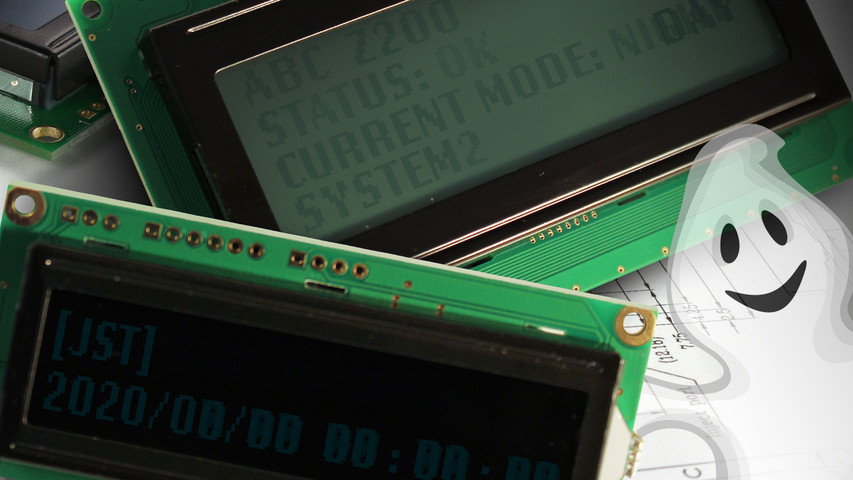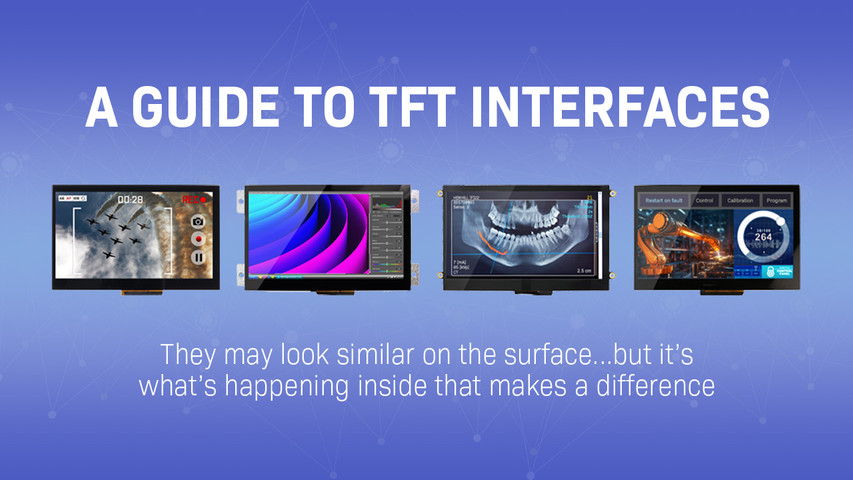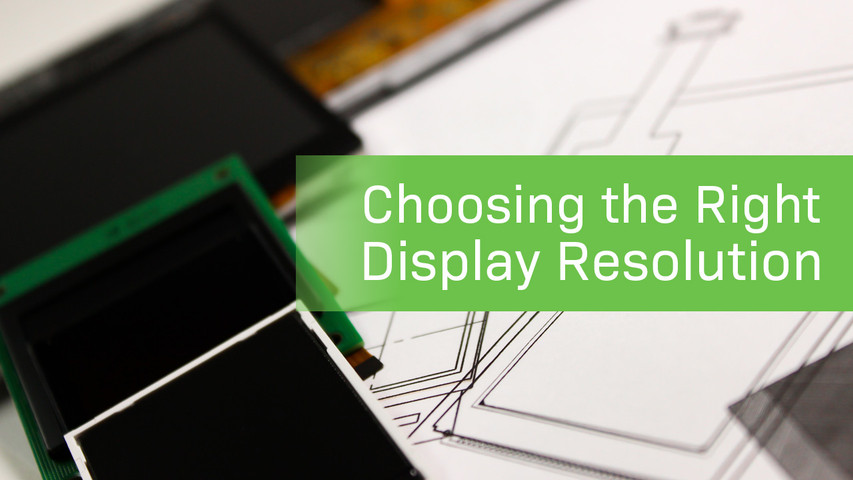Screen Burn-In
Image burn-in affects all screen displays, including LCDs and OLEDs in mobile phones, monitors, wearable devices, televisions, and all electronic devices with a display screen. This article will cover everything you need to know about image burn-in and ways to mitigate it.
Ecco cosa imparerete in questo post:
What is Screen Burn-in?
Screen burn, also known as burn-in, occurs when a persistent image leaves a permanent ghost-like imprint on a display. While this issue is most commonly associated with OLED (Organic Light-Emitting Diode) displays, LCDs (Liquid Crystal Displays) can also experience a form of temporary image retention called image persistence. Understanding how different display technologies respond to prolonged static images is crucial for engineers designing applications in industrial, medical, and commercial environments.
Correlato: Cos'è la scarica elettrostatica (ESD)
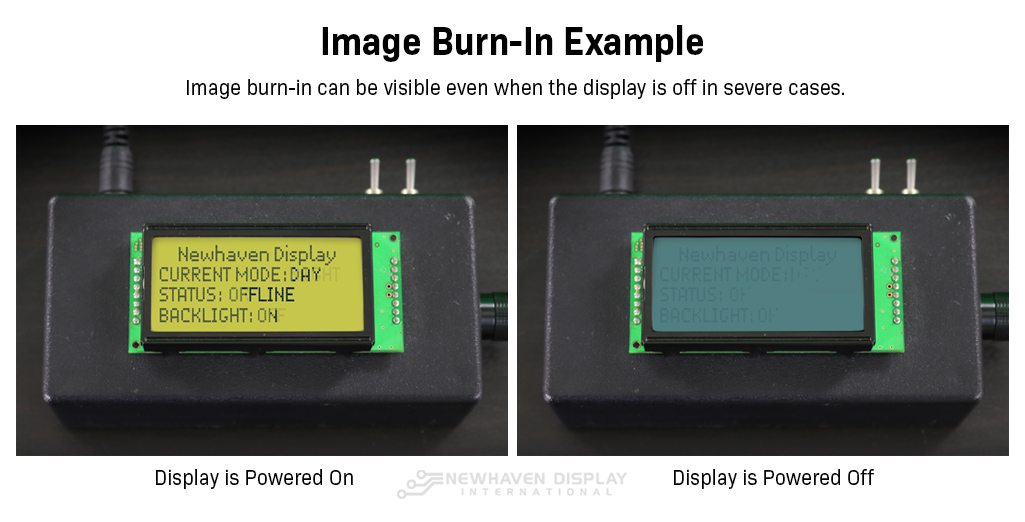 Esempio di bruciatura dell'immagine sul display LCD.
Esempio di bruciatura dell'immagine sul display LCD.
Burn-In vs. ritenzione dell'immagine
Chances are you've encountered image burn-in and image retention before, but you didn't know which one you were seeing. They both have the same visual effects, so it's easy to mistake them for each other, but there's one key difference: image retention is temporary, and image burn-in is permanent.
We've seen many misleading articles, videos, and guides about "fixing" image burn-in or removing it from a display. Image burn-in is completely irreversible once it occurs on your display screen.
Nella maggior parte dei casi, queste guide spiegano come funziona la conservazione delle immagini e come è possibile accelerare il processo di recupero. Vogliamo chiarire qualsiasi confusione che si possa avere in merito al burn-in e alla ritenzione dell'immagine sui display LCD e OLED.
Conservazione dell'immagine
La ritenzione dell'immagine, nota anche come ghosting o persistenza dell'immagine, è l'effetto temporaneo delle immagini che rimangono visibili su LCD o OLED per un breve periodo, di solito pochi secondi.
How to tell the difference between image retention and screen burn-in?
Se le immagini svaniscono dopo poco tempo, si tratta di una ritenzione temporanea dell'immagine. Se invece le immagini rimangono permanenti, si tratta di un problema di burn-in dell'immagine.
Image retention doesn't require any intervention from the user to make it go away – it'll do that by itself. Retention will often occur before burn-in does on newer display technology like our TFTs and our new IPS displays.
Correlato: Cos'è un display IPS?
Image retention will fade away, but there are some tips you can use to speed up the process. Simple actions like using a screen saver, cycling various graphics on the screen to exercise the pixels, and powering off the display whenever possible will help clear the image retention on your display.
Questi sono gli stessi trucchi che vedrete pubblicizzati come "cura" per il burn-in delle immagini, ma non lasciatevi ingannare. Non esiste una cura per il burn-in, ma solo un modo per evitare che si verifichi.
Prima di pensare che il vostro schermo sia danneggiato dal burn-in, provate a seguire questi consigli e aspettate di vedere se si tratta solo di ritenzione di immagine. La ritenzione di immagine è un fenomeno innocuo e comune a molti schermi.
What Causes Screen Burn-in?
Screen burn-in is caused by screen pixels that stay activated in a static position for long periods of time. Think of a TV in a lobby or waiting area that's always playing the same news channel. The news channel footer and logo get burned into the screen permanently, even when you change the channel.
Le cause più comuni di burn-in del display sono: immagini statiche, messaggi, loghi e icone.
Nei telefoni cellulari, ad esempio, la bruciatura dell'immagine può essere causata dalla posizione statica permanente delle icone della batteria, del wifi e del segnale di servizio.
Quando i pixel LCD o OLED rimangono attivati in una posizione statica, finiscono per rimanere "bloccati" in quella posizione. Quando ciò accade, si nota un'immagine sbiadita e ostinata che persiste sullo schermo.
Burn-in su display LCD e OLED
Il risultato del burn-in è lo stesso su tutti i tipi di schermo, ma il modo in cui si verifica su LCD e OLED è leggermente diverso.
Correlato: Differenze tra OLED e LCD
Come si verifica il burn-in negli LCD
Dopo aver visualizzato un'immagine statica per lunghi periodi di tempo, i cristalli di un display a cristalli liquidi diventano più deboli da muovere e hanno più difficoltà a passare dalla posizione completamente "ON" alla posizione completamente "OFF".
Quando i pixel non si attivano o si disattivano del tutto, si creano immagini sbiadite che non si cancellano dallo schermo. Questo fenomeno è comune nelle applicazioni che utilizzano LCD a caratteri, in cui i caratteri alfanumerici vengono aggiornati meno frequentemente.
Nell'esempio seguente, si nota un'impronta permanente sbiadita del testo lasciato sullo schermo LCD dopo lo spegnimento del display.
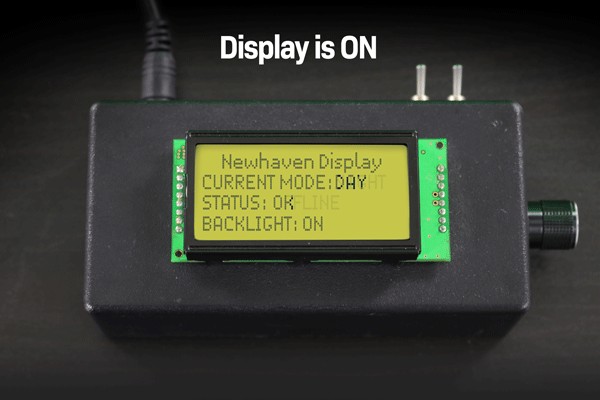 Esempio di bruciatura dell'immagine LCD dei caratteri quando il display è acceso e spento.
Esempio di bruciatura dell'immagine LCD dei caratteri quando il display è acceso e spento.
Come si verifica il burn-in negli OLED
Gli OLED sono unici perché non hanno bisogno di una retroilluminazione per illuminarsi. Ogni pixel del display è un LED auto-illuminante, quindi genera luce propria. Tuttavia, i pixel perdono inevitabilmente luminosità con il passare del tempo. Quanto più a lungo un pixel OLED è illuminato, tanto più appare debole accanto ai pixel meno utilizzati.
Se un'immagine statica rimane su un display OLED abbastanza a lungo, i pixel lasciano un'ombra dietro l'immagine precedente, anche quando il display mostra qualcosa di completamente diverso.
Nell'esempio che segue, si può osservare come il testo "Double Height" sia impresso nell'OLED.
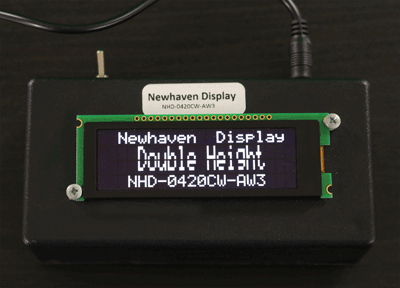 Esempio di burn-in dell'immagine OLED.
Esempio di burn-in dell'immagine OLED.
Ricordate: Non c'è modo di rimuovere o ridurre la bruciatura dopo che si è verificata. Se un'immagine ostinata persiste per lunghi periodi o dopo il riavvio dello schermo, è probabile che si tratti di burn-in dell'immagine.
Early Signs of LCD Screen Burn
LCDs don’t suffer from permanent burn-ins like OLEDs, but they can experience a temporary form known as image persistence. This occurs when a static image lingers faintly on the display even after the display content changes. Here are the early signs to watch for:
-
Ghosting or faint remnants of a previous image: If you can still see a shadow of a menu bar, logo, or other static content after switching screens, this is an indication of image retention.
-
Slow response time when transitioning images: If pixels take longer to refresh or adjust to new content, especially in high-contrast areas, your LCD may be experiencing early image persistence.
-
Color distortion in affected areas: Some parts of the display may appear slightly discolored or "washed out" after extended exposure to static content.
-
Variations across LCD types: IPS (In-Plane Switching) panels, commonly used for wide-viewing angles, are less prone to persistence than TN (Twisted Nematic) panels, which have faster response times but may exhibit minor retention effects.
If detected early, image persistence can be reversed by turning off the display or using a display refresh function. However, extended exposure to static content increases the risk of more stubborn retention.
LCD Applications Prone to Burn
While LCDs are less susceptible to permanent burn-in than OLEDs, certain industries rely on displays that frequently show static images, making them more prone to image persistence.
-
Medical Equipment Displays: Patient monitoring systems, diagnostic screens, and imaging devices often show static vital signs, graphs, or interface elements for extended periods, increasing the likelihood of image retention.
-
Industrial Control Panels: Factory automation screens, process control monitors, and instrumentation panels display static data, such as readouts and system statuses, for long durations.
-
Point-of-Sale (POS) Systems: Retail checkout displays and kiosks frequently show the same user interface for hours, leading to uneven pixel wear.
-
Automotive and Marine Displays: Navigation systems, dashboard readouts, and infotainment screens may hold the same map or gauge interface for long periods, causing temporary retention.
-
Test and Measurement Devices: Oscilloscopes, spectrum analyzers, and other laboratory instruments often feature fixed graphical elements, which can contribute to image persistence over time.
Newhaven Display’s TFT LCD modules are engineered with pixel-shifting technology, optimized brightness control, and advanced refresh techniques to minimize image retention. These design enhancements help extend the longevity and reliability of displays in mission-critical applications.
Early Signs of OLED Screen Burn
Unlike LCDs, OLED displays are more vulnerable to permanent burn-in due to their self-emissive pixels, which can degrade at different rates over time. Understanding the conditions that accelerate this process is essential for engineers designing long-lifespan products. Signs of OLED burn-in include:
-
Persistent ghost images: Static elements, such as logos or user interface (UI) components, remain visible even after switching displays, indicating pixel wear.
-
Uneven brightness levels: Frequently used areas may appear dimmer due to pixel aging, where some pixels degrade faster than others.
-
Color shifting or distortion: Affected regions may develop color imbalances, such as a reddish, yellowish, or bluish tint where burn-in has occurred.
-
Noticeable differences in high-contrast areas: Burn-in is most apparent where bright elements frequently overlay darker backgrounds, causing uneven luminance.
OLED Applications Prone to Burn
OLED displays offer vibrant colors and high contrast, making them ideal for many applications. However, certain use cases increase the likelihood of burn-in:
-
Medical and Diagnostic Displays: Patient monitoring systems and imaging equipment often maintain static readings and graphical elements.
-
Industrial and Automation Interfaces: Factory control displays frequently show persistent navigation menus and system statuses.
-
Handheld and Portable Devices: OLED-based test equipment, communication devices, and specialized tools often display static UI components.
-
Automotive and Aerospace Displays: Digital dashboards, heads-up displays (HUDs), and in-flight entertainment screens maintain fixed navigation elements and branding.
-
Retail and Commercial Signage: OLED advertising displays that feature static logos, pricing, or promotional graphics are at higher risk.
To mitigate OLED burn-in, Newhaven Display designs its OLED modules with pixel wear-leveling, automatic brightness adjustment, and built-in display refresh cycles. These features help extend the operational life of OLED displays used in high-contrast applications.
How to Test for Screen Burn
Detecting screen burn early can help prevent further pixel degradation. Here are a few methods to test for screen burn on LCD and OLED displays:
-
Full-Screen Color Tests: Displaying a solid color background (such as white, red, green, or blue) at full brightness can reveal ghost images or uneven pixel wear.
-
Gradient and Gray Screen Tests: Viewing a gradient pattern or a uniform gray background can help detect subtle color shifts, which may indicate early signs of burn-in.
-
Switching Between High-Contrast Images: Quickly alternating between bright and dark images can make burn-in effects more noticeable, especially in frequently used areas of the display.
-
Using Specialized Burn-in Test Tools: Some diagnostic applications generate test patterns designed to highlight persistent image retention or OLED burn-in.
If mild image retention is detected, running a pixel refresh cycle, adjusting brightness levels, or using a screen saver can help reduce visibility. However, permanent burn-in on OLED displays cannot be reversed, making proactive prevention the best approach.
Ways to Mitigate/Avoid Screen Burn-in
Anche gli schermi più avanzati prima o poi si bruciano, ma ci sono alcune semplici azioni che si possono intraprendere per prolungare la durata di vita dello schermo prima che si verifichi la bruciatura. Con le pratiche corrette, è possibile ottenere anni di prestazioni eccellenti dal display senza alcun effetto di burn-in.
How to avoid screen burn-in
- Spegnere il display quando non viene utilizzato
- Utilizzare uno screensaver
- Esercitare i pixel (effetto rotazione o scorrimento)
- Ridurre la luminosità o il contrasto dello schermo
Correlato: Come pulire un display elettronico
Lo sapevate? I salvaschermi prendono il nome dal loro scopo originario, che era un metodo attivo per cercare di attenuare il burn-in dello schermo.
Spegnere il display quando non viene utilizzato
Sappiamo che in alcuni casi è necessario un display "sempre acceso" o che il display deve rimanere acceso per lunghi periodi.
Se ne avete la possibilità, eseguite un ciclo di accensione completo del display. In questo modo si resettano i pixel e si evita il burn-in.
Se non è possibile eseguire un ciclo di alimentazione, è possibile utilizzare il comando ON/OFF del display per spegnerlo. In alternativa, è possibile mettere il display in modalità di sospensione, mantenendo i dati del display nella RAM.
Utilizzare uno screensaver
Uno screensaver è una buona alternativa se non è possibile spegnere lo schermo. Per gli schermi che non devono essere sempre accesi, è utile lasciare lo schermo a riposo quando non viene utilizzato.
Uno screensaver o una modalità di sospensione consentono un avvio rapido rispetto allo spegnimento e riaccensione completa del dispositivo.
Esercitare i pixel
Fate muovere i pixel! Quanto più a lungo un pixel rimane attivato in una posizione statica, tanto più si avvicina a essere bruciato. È possibile esercitare i pixel dello schermo facendo scorrere il testo, muovendo le immagini o cambiando i colori.
Questa tecnica è simile alla rotazione degli pneumatici dell'auto. L'obiettivo è distribuire uniformemente l'usura sull'intero display.
Ridurre la luminosità o il contrasto dello schermo
Ridurre la luminosità dello schermo quando possibile. Una maggiore illuminazione (luminosità) richiede più corrente, riducendo la durata di vita dei LED.
Per un display OLED, diminuendo il contrasto si riduce la luminosità e la velocità di masterizzazione dell'immagine. Una maggiore illuminazione (luminosità) richiede più corrente, riducendo la durata di vita dei pixel OLED.
Per un display LCD, l'abbassamento del contrasto riduce le sollecitazioni sui cristalli liquidi e contribuisce a ridurre la frequenza dei pixel che si indeboliscono o si incollano.
Tutto sul burn-in di LCD e OLED - [Video]
Find more helpful videos like this on our YouTube channel.
Conclusione
Ricordate che la bruciatura dell'immagine non è reversibile e non può essere riparata una volta che si è verificata. Che si tratti di un effetto di scorrimento, di una rotazione dei pixel, dell'uso di uno screensaver o dello spegnimento dello schermo quando non viene utilizzato, è essenziale adottare misure preventive contro la bruciatura delle immagini per contribuire a prolungare la durata di vita del display.
Ultimi post del blog
-
A Guide to TFT Display Interfaces
Display interfaces often get less attention than screen resolution or brightness, but they carry jus …Dec 16th 2025 -
Choosing the Right Display Resolution: A User-Friendly Guide
Display resolution is one of the most defining choices in product interface design. It determines ho …Dec 11th 2025 -
Arduino vs Raspberry Pi vs BeagleBone: Key Features and Differences
If you're working on an electronics project—whether it's for a DIY automated device, a digital sign, …Dec 8th 2025

